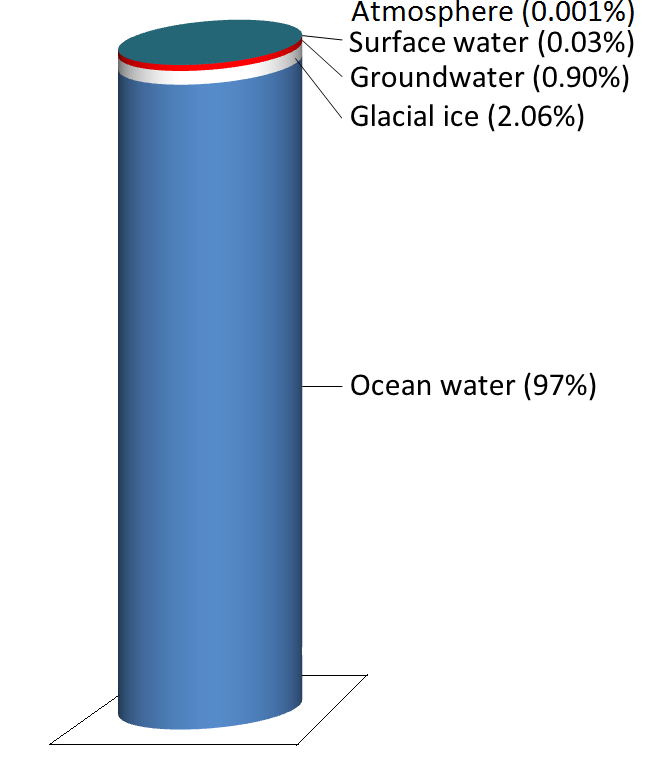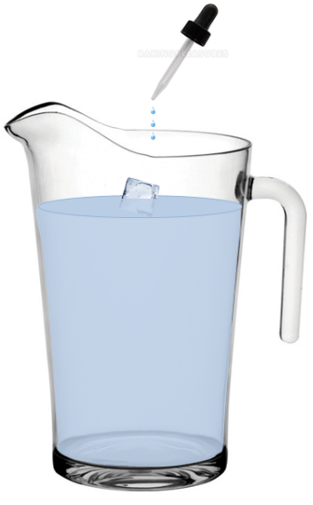What is Water – The Hydrological Cycle: Overview of Water Cycle (Reading)
Required Reading: “The Water Cycle”
Estimated time: 15 Minutes
A unique aspect of life on Earth is that water exists in all three states – as a gas, as liquid and as a solid. Water in its liquid state is capable of absorbing massive amounts of energy. When light from the sun hits the Earth, the atmosphere (including atmospheric water) and oceans absorb this energy. Daily and annual energy fluctuations and exchanges between water reservoirs drive weather and climate.
I believe it is important to have a foundational understanding of how our water system works, how we depend upon it, and the anthropological effects that society has upon this resource. We can look at water on multiple levels – from global changes in the what is known as the water cycle to our local communities and our homes. They are all connected.
For this reading, I’ve chosen section 13.1 (The Hydrological Cycle) of the open textbook Physical Geology; written by Steven Earle, this book and the excerpted section below, is licensed under a Creative Commons Attribution 4.0 International License (except where otherwise noted).
This text has two full chapters on water related matters (Surface and Ground Water), as well as excellent background material for the geological context of climate change if you choose to look deeper into components of the water cycle.
As you review the materials, ask yourself similar questions to that you were asked to consider with respect to food in module 1:
- How do you define water?
- What does water mean to you?
- How does is relate to your everyday life.
I’d also like you to consider these two additional questions:
- What do we mean by a cycle?
- Why is the concept of a cycle important in our considerations of climate change and adaptation?
Chapter 13.1, The Hydrological Cycle
- Excerpted and modified to ensure images are consistently displayed from https://opentextbc.ca/geology/chapter/13-1-the-hydrological-cycle/
- Earle, S. (2015). Physical Geology. Victoria, B.C.: BCcampus. Retrieved from https://opentextbc.ca/geology/
- Download for free from the B.C. Open Textbook Collection
Water is constantly on the move. It is evaporated from the oceans, lakes, streams, the surface of the land, and plants (transpiration) by solar energy (Figure 13.2). It is moved through the atmosphere by winds and condenses to form clouds of water droplets or ice crystals. It comes back down as rain or snow and then flows through streams, into lakes, and eventually back to the oceans. Water on the surface and in streams and lakes infiltrates the ground to become groundwater. Groundwater slowly moves through the rock and surficial materials. Some groundwater returns to other streams and lakes, and some goes directly back to the oceans.

Even while it’s moving around, water is stored in various reservoirs. The largest, by far, is the oceans, accounting for 97% of the volume (Figure 13.3). Of course, that water is salty. The remaining 3% is fresh water. Two-thirds of our fresh water is stored in ice and one-third is stored in the ground. The remaining fresh water — about 0.03% of the total — is stored in lakes, streams, vegetation, and the atmosphere.

To put that in perspective, let’s think about putting all of Earth’s water into a 1 L jug (Figure 13.3b). We start by almost filling the jug with 970 ml of water and 34 g of salt. Then we add one regular-sized (~20 mL) ice cube (representing glacial ice) and two teaspoons (~10 mL) of groundwater. All of the water that we see around us in lakes and streams and up in the sky can be represented by adding three more drops from an eyedropper.

Although the proportion of Earth’s water that is in the atmosphere is tiny, the actual volume is huge. At any given time, there is the equivalent of approximately 13,000 km3 of water in the air in the form of water vapour and water droplets in clouds. Water is evaporated from the oceans, vegetation, and lakes at a rate of 1,580 km3 per day, and just about exactly the same volume falls as rain and snow every day — over both the oceans and land. The precipitation that falls on land goes back to the ocean in the form of stream flow (117 km3/day) and groundwater flow (6 km3/day). Most of the rest of this chapter is about that 117 km3/day of streamflow. The average discharge of the Fraser River into the ocean is approximately 0.31 km3/day, or 0.26% of the world’s total.

